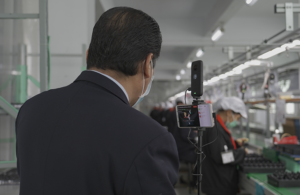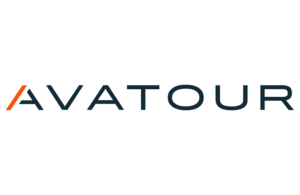
Avatour technology in use at a Seqens facility
While COVID-19 has led to an uptick in remote inspections and virtual training, the startup Avatour (San Francisco) was working on its remote presence platform before the pandemic.
Devon Copley, CEO of the company, was the head of product, VR platform for Nokia from 2015 to 2017, where he was involved in creating a novel Nokia OZO 360° camera. “That was a $60,000 device made out of a single block of CNC-machined aluminum,” Copley recalled. “It was a beautiful piece of engineering, but a little ahead of its time, as it turned out.”
After Nokia decided to cancel the project, Copley reached out to Prasad Balasubramanian, who was in charge of the engineering team for the OZO advanced camera.
Over beers, the two concluded that the concept of enabling individuals to remotely visit a location and talk to individuals there in real-time would be valuable. Avatour was launched in January 2018.
 The focus of the OZO project was largely on entertainment. “It was largely on sports, music and these sorts of things, which were great fun, but there wasn’t a real market for it,” Copley said.
The focus of the OZO project was largely on entertainment. “It was largely on sports, music and these sorts of things, which were great fun, but there wasn’t a real market for it,” Copley said.
Remote training, inspections, audits, and consulting related to inspections and audits are a natural fit for the technology.
Avatour counts a growing number of life-science organizations as customers, including ThermoFisher Scientific, pharma ingredients company Seqens, regulatory affairs–focused Lachman Consultants and some regulators.
The company is also working with non-governmental organizations and nonprofits who are assisting with establishing vaccine production sites in various locations around the world. “For those kinds of applications, travel is still impossible,” Copley said. “But even in the best of circumstances, travel to someplace like Bangladesh or Ghana is extremely expensive and challenging.”
Falling hardware costs also enable Avatour to offer roughly equivalent functionality to the OZO camera for about $1,500.

Devon Copley
The company uses off-the-shelf hardware for its technology, opting to offer an annual subscription based on the number of devices in use.
One device can support up to 20 remote users simultaneously. “They can be anywhere in the world, and each one of them can be looking in a different direction in the room,” Copley said.
Users can take snapshots and take digital notes with location tags to review later as part of the report. “And we will be rolling out recording functionality, where you can record that entire inspection, audit, walkthrough whatever it is,” Copley. “You can go back and review that recording and look at the thing you didn’t see the first time.”
Whereas smart glasses technologies can offer remote support to an individual technician, Copley says 360° cameras are a better fit for different use cases. Examples include remote audits, site installations involving a large machine and a method transfer involving multiple parts in a lab. “Anytime you have multiple remote users who each want to choose their own point of view, rather than just see what one person sees” is a potential fit, Copley said.
“We’re working with a lot of internal quality assurance teams across quite a variety of major manufacturers, and also for supply chain,” he said.
The company has seen demand for auditing of manufacturers or suppliers.
Ultimately, Copley said that remote collaboration tools would not entirely replace in-person collaboration. “But it can become a sort of 80/20 solution,” he said. “Maybe, 80% of the things that you used to travel for, or you used to have to be in-person for, you can substitute a digital technology like Avatour,” he said. “You can’t do replace all of it —especially when it’s about forming new relationships between people. There’s something to be said for having a glass of wine with somebody or just being in their physical presence.”
But having a range of remote working tools available can enable a continued shift toward remote work for organizations that embrace them. “If Zoom is the only hammer you have, then everything looks like a nail,” Copley said.